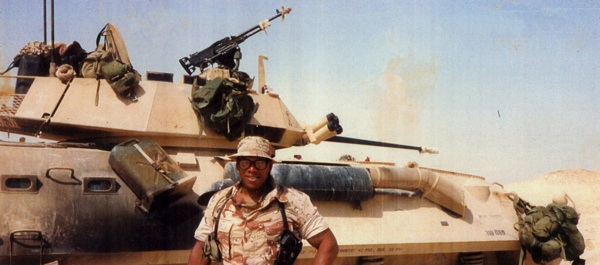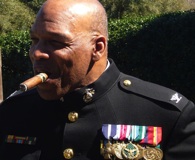Operation Desert Storm – 20 Years Later

Marine Lieutenant Colonel Eddie Ray led the 1st Marine Regiment’s charge to Baghdad as commander of the 2nd Light Armored Reconnaissance (LAR) Battalion at the beginning of Operation Iraqi Freedom in 2003. This was not his first taste of battle. Ray is a decorated veteran of Operation Desert Storm. It is hard to believe that it has been twenty years since coalition forces ejected the Iraqi Army from Kuwait. Contrary to popular belief, the Iraqi Army stood and fought our advance into Kuwait. Following is a short, updated, excerpt from “The Gulf War Chronicles” which reveals the details of Ray’s first encounter with Saddam’s army.
If I die today, my wife is going to kill me.
By the end of the first day of the ground war, Task Force Ripper had Al Jaber Airfield, in Southern Kuwait, under siege and Task Force Papa Bear was protecting the right flank of the 1st Marine Division. General Thomas Draude, the 1st Marine Division’s assistant commander, had led the division’s “Jump” CP forward into Kuwait during the afternoon. He set up the forward command post somewhere between Task Force Ripper and Papa Bear with the burning Burqan Oil Field just east of his site. A young intelligence captain cautioned the general that he believed the Iraqis were massing for a counterattack in the center of the facility. Draude discounted the warning believing that no one could tolerate the heat from the dozens of fires raging throughout the field.
{default}Throughout the night of February 24–25, 1991, Marines received more and more information indicating that there was an Iraqi armor brigade and a mechanized infantry brigade on the 1st Marine Division’s right flank in the Burqan Oil Field. So, plans were made to flush these Iraqis out with a massive artillery barrage the next morning.
 Prior to the artillery barrage, at 0715, the commanders of Task Force Papa Bear started a morning staff meeting at their field headquarters, just southwest of the Burqan Oil Field. As the Regiment’s senior officers were discussing the day’s plans, a single Iraqi tank and a Chinese-built Armored Personnel Carrier (APC) appeared not one hundred yards from the officers. Smoke from the oil fires was so bad on this morning that the Iraqis had wandered unseen through the Marine sentry posts. Fortunately these Iraqis had ventured out to surrender. Their senior officer volunteered that the rest of his brigade was close behind and that they wanted to fight.
Prior to the artillery barrage, at 0715, the commanders of Task Force Papa Bear started a morning staff meeting at their field headquarters, just southwest of the Burqan Oil Field. As the Regiment’s senior officers were discussing the day’s plans, a single Iraqi tank and a Chinese-built Armored Personnel Carrier (APC) appeared not one hundred yards from the officers. Smoke from the oil fires was so bad on this morning that the Iraqis had wandered unseen through the Marine sentry posts. Fortunately these Iraqis had ventured out to surrender. Their senior officer volunteered that the rest of his brigade was close behind and that they wanted to fight.
Around 0815, five battalions of Marine artillery began pounding the suspected Iraqi positions in the Al Burqan Oil Field. Sixty-six howitzers fired two hundred forty-four rounds in the first volley. Three minutes later a second salvo unleashed nearly five hundred more rounds. The young intelligence officer had called it right. The Iraqi 5th Mechanized Division had spent all night massing in the cover of Burqan preparing to counterattack the 1st Marines.
Within fifteen minutes, RCT-1 reported: "T-62s everywhere, scattering like cockroaches from the Burqan Oil Field." Papa Bear’s commanders immediately called for close air support. Captain Randall Hammond responded to the call for help. He brought his four Cobra helicopters in to attack the advancing Iraqis. Smoke still obscured the battlefield, but unlike the night before, the Arabian sun helped the Cobra pilots see through the billowing smoke. Scout Marines on the ground painted targets for the Cobra pilots while they launched their Hellfire missiles at the Iraqi armored vehicles. With the help of Hammond’s Cobras and other pilots, the 1st Tank Battalion beat back the brigade-sized attack on Papa Bear’s position after three and a half hours of fighting. The combined air-ground defense destroyed fifty tanks and twenty-five APCs. Papa Bear’s Marines herded three hundred dazed Iraqi soldiers from the battlefield.
 Eight miles to the north, General Draude monitored Papa Bear’s battle from the 1st Division’s forward command post located on the western edge of the Emir’s Farm. The Emir’s Farm was a small oasis located directly to the east of the Division’s breach head. Only a rifle platoon and a LAV platoon from the 1st LAI Battalion protected the Division forward command post. Captain Eddie Steven Ray had his seven LAV-25s positioned on a screen line, about a quarter of a mile east of General Draude’s command unit. The rifle platoon was dug in to Ray’s north.
Eight miles to the north, General Draude monitored Papa Bear’s battle from the 1st Division’s forward command post located on the western edge of the Emir’s Farm. The Emir’s Farm was a small oasis located directly to the east of the Division’s breach head. Only a rifle platoon and a LAV platoon from the 1st LAI Battalion protected the Division forward command post. Captain Eddie Steven Ray had his seven LAV-25s positioned on a screen line, about a quarter of a mile east of General Draude’s command unit. The rifle platoon was dug in to Ray’s north.
Around 0930, Iraqi artillery rounds began falling near the rifle platoon. Ray raced north in his LAV, to find Iraqi Armored Personnel Carriers (BMPs) disgorging troops on the edge of the oasis. Ray and the rifle platoon opened fire on the advancing Iraqis. Realizing that his division commander was in immediate danger, Captain Ray called for his platoon to come north and engage the enemy.
Meanwhile, General Draude and his staff watched as an Iraqi mechanized brigade attacked out of the oasis. Draude turned to an aid and quipped. “If I die today, my wife is going to kill me.” The 1st Marine Division’s Operations Officer, Colonel Jerry Humble, immediately called Task Force Ripper for reinforcements (armed with TOW missiles), then called I MEF headquarters.
"We need some help!" he exclaimed. "Send all the Cobras you can."
A MEF staff officer replied that everybody was in a fight. Colonel Humble raised the handset into the air, waited a few seconds, then said: "…we’re in a REAL fight at Division Forward."
"Oh, shit, I hear," the staff officer answered.
 Meanwhile, Ray began picking off BMPs with his 25-mm cannon fire. Within minutes, Ray’s other LAVs were on line. Artillery support was out of the question. The enemy was too close. Within moments, two Cobra gunships swooped in at low level. Ray directed their rocket fire by shooting his 25-mm cannon at Iraqi infantry positions.
Meanwhile, Ray began picking off BMPs with his 25-mm cannon fire. Within minutes, Ray’s other LAVs were on line. Artillery support was out of the question. The enemy was too close. Within moments, two Cobra gunships swooped in at low level. Ray directed their rocket fire by shooting his 25-mm cannon at Iraqi infantry positions.
Then Ray counterattacked. Supported by the gunships overhead, Ray’s seven LAVs rolled forward toward the oasis. More Cobras arrived and the LAV platoon pressed the attack, destroying everything in sight. Captain Ray and his men swept through the oasis. The Marines halted on the eastern edge of the Emir’s Farm. Thirty-eight burning Iraqi armored vehicles lay scattered behind them. Ray had not only protected the command post but his aggressive counterattack completely destroyed the Iraqi brigade. Captain Ray received the Navy Cross for his courage under fire that day.
Discover what really happened in Desert Storm. Visit www.gwchronicles.com.
About the Author
Richard S. Lowry is an internationally recognized military historian and author, specializing in the wars in Afghanistan and Iraq. His latest book, New Dawn, the Battles for Fallujah (Savas Beatie LLC, 2010), has been nominated for the 2011 Pulitzer Prize in History and the Marine Corps Heritage Foundation’s coveted Wallace M. Greene, Jr. award. Military Writers Society of America awarded New Dawn a Gold Medal; the society previously awarded Richard’s Marines in the Garden of Eden (Berkley Caliber, 2006) a Silver Medal. His other works include The Gulf War Chronicles (iUniverse, 2003 and iUniverse Star, 2008), and US Marine in Iraq: Operation Iraqi Freedom, 2003 (Osprey, 2006). Additionally, he contributed to Small Unit Actions (United States Marine Corps History Division, 2008).
Richard can be found online at his blog site,and his continuing military news column.

